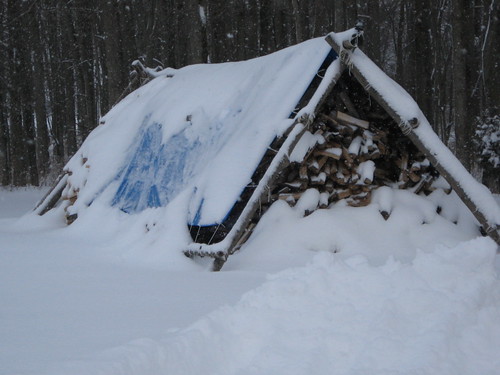I'll be 55 in January... I've been burning wood for heat in the house since my early 20's (with a couple of short hiatuses). Before that, both my Granddad and dad burned wood in stoves and fireplaces; so really, I’ve been around in-home wood burning since I was wearing diapers. We never “covered” firewood, and I still don’t… with the exception of (sometimes) laying some old boards or such, only on the stack(s) I plan on using that heating season, just before first snow. I don’t do it to keep the wood “dry”, it’s more so I can easily throw the ice and snow off before hauling it to the house. Some years I don’t even bother with that and just brush the snow off when I do the cars. Granddad had a woodshed (lean-to) that he would move some fully seasoned firewood under just before first snow… but that was more to keep Grandma out of the weather when she stepped outside to grab an armload.
I’ve never had a problem with “wet” firewood. Sure, when it rains the top couple of rows and maybe the ends on one side of the stack (wind and rain) get a little wet, but it dries right off in a day or two… even in sub-zero weather. Rain water doesn’t “soak in”, heck most of it runs off and drips on the ground; and like I said, I rarely find wet wood any deeper than two or three rows anyway… even after three days of rain. Really, storing firewood in a shed or covering it just keeps the rain and snow off it… but it can’t stop damp, humid, foggy atmosphere from getting to the wood (unless your shed is climate controlled).
Until I joined AS I’d never heard of storing unseasoned (fresh-cut/split) firewood under cover or in a shed. A woodshed is where you stored the stuff after it had fully seasoned in the open for a couple years… and few people even bother with the shed anyway.
Take those covers off your firewood so it gets plenty of air and sun when it shines… it will stay dryer in the long-run. If ya’ know a healthy rainstorm is on the way just haul enough wood under cover to last for a couple days… and if ya’ don’t it ain’t a big deal… three rows down will be dry firewood, and the wet stuff will be dry tomorrow. Heck, haul some rain-wet firewood in the house and set it by the hot stove, it’ll be bone-dry in an hour or two… even less than an hour, depending. For that matter, just toss it in the hot stove; it ain’t like ya’ do it every day, and the wood is only “wet” on the outside… it ain’t like you’re tossing “green” firewood in there.
If ya’ want a woodshed then you should have one… but only use it to store fully seasoned firewood.
Personally, I don't care to handle and move mine that much.








